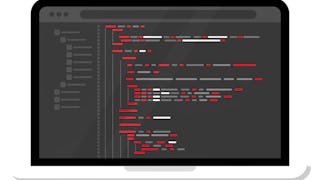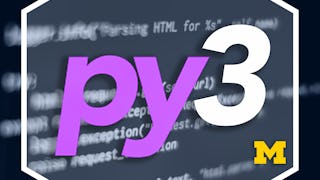ستقدم هذه الدورة التدريبية بُنى البيانات الأساسية للغة برمجة Python. وسوف نتجاوز أساسيات البرمجة الإجرائية ونستكشف الكيفية التي يمكننا من خلالها استخدام بُنى بيانات Python المضمَّنة، مثل القوائم والقواميس والمجموعات لإجراء تحليل معقد بشكل متزايد للبيانات. ستغطي هذه الدورة التدريبية الفصول من 6 إلى 10 من كتاب «Python للجميع» النصي. وستغطي هذه الدورة التدريبية Python 3.

Enjoy unlimited growth with a year of Coursera Plus for $199 (regularly $399). Save now.

What you'll learn
شرح مبادئ بُنى البيانات وكيفية استخدامها
إنشاء برامج قادرة على قراءة وكتابة البيانات من الملفات
تخزين بيانات مثل أزواج القيم/الأزواج الرئيسية باستخدام قواميس Python
إنجاز مهام متعددة الخطوات مثل الفرز أو التكرار باستخدام المجموعات
Skills you'll gain
Details to know

Add to your LinkedIn profile
See how employees at top companies are mastering in-demand skills

There are 7 modules in this course
في هذا الفصل الدراسي، سنتابع من حيث توقفنا في الفصل الدراسي السابق، بدءًا من الفصل 6 من الكتاب النصي لنغطي السلاسل النصية وننتقل إلى بُنى البيانات. ويُخصص الأسبوع الثاني من هذا الفصل الدراسي لتثبيت Python، إذا كنتم تريدون بالفعل تشغيل التطبيقات على كمبيوتر سطح مكتب أو جهاز الكمبيوتر المحمول الخاص بكم. إذا اخترتم تثبيت Python، فيمكنكم تخطي الأسبوع الثالث والتقدم في الدورة.
What's included
7 videos7 readings1 assignment1 app item
في هذه الوحدة سوف تقومون بإعداد الأشياء حتى تتمكنون من كتابة برامج Python. ونحن لا نطلب تثبيت Python لهذا الفصل الدراسي. ويمكنكم كتابة واختبار برامج Python في المتصفح باستخدام "Python Code Playground" في هذا الدرس. يُرجى قراءة مادة "استخدام Python في هذا الفصل الدراسي" للاطلاع على التفاصيل.
What's included
5 videos2 readings1 peer review1 app item
حتى الآن، كنا نعمل باستخدام البيانات التي تتم قراءتها من المستخدم أو البيانات في الثوابت. لكن البرامج الفعلية تعالج كميات كبيرة للغاية من البيانات عن طريق قراءة وكتابة الملفات في تخزين ثانوي على جهاز الكمبيوتر الخاص بكم. وفي هذا الفصل نبدأ في كتابة برامجنا الأولى التي تقرأ وتفحص وتعالج البيانات الحقيقية.
What's included
5 videos1 reading1 assignment2 app items
نظرًا لأننا نريد حل المشكلات الأكثر تعقيدًا في Python، فنحن بحاجة إلى متغيرات أكثر قوة. حتى الآن، كنا نستخدم متغيرات بسيطة لتخزين الأرقام أو السلاسل حيث يكون لدينا قيمة واحدة في أي متغير. وبدءًا من القوائم، سنُخزِّنُ العديد من القيم في متغير واحد باستخدام مخطط فهرسة لتخزين قيم مختلفة من داخل متغير واحد وتنظيمها واستردادها. ونحن نطلق على هذه المتغيرات متعددة القيم اسم "المجموعات" أو "بُنى البيانات".
What's included
7 videos1 assignment2 app items
يُعد قاموس Python أحد أقوى بُنى البيانات. فبدلًا من تمثيل القيم في إحدى القوائم الخطية، تُخزِّنُ القواميس البيانات في صورة أزواج أساسية / أزواج قيم. يمنحنا استخدام الأزواج الأساسية / أزواج القيم "قاعدة بيانات" في الذاكرة في متغير Python واحد.
What's included
7 videos1 assignment1 app item
المجموعات هي بنية بيانات Python الأساسية الثالثة والأخيرة التي سنتناولها. المجموعات هي إصدار بسيط من القوائم. وغالبًا ما نستخدم المجموعات جنبًا إلى جنب مع القواميس لإنجاز مهام متعددة الخطوات مثل الفرز أو التكرار خلال جميع البيانات في أحد القواميس.
What's included
6 videos1 assignment1 app item
للاحتفال بوصولكم إلى نقطة منتصف الطريق في تخصص «Python للجميع»، فإننا نرحب بكم لحضور حفل تخرُّجنا عبر الإنترنت. وهو حفل ليس طويلًا للغاية، ويتميز بمتحدث في حفل التخرج وخطاب قصير جدًا عن حفل التخرج.
What's included
2 videos3 readings
Instructor

Offered by
Explore more from Software Development
 Status: Preview
Status: Preview Status: Preview
Status: PreviewUniversity of Leeds

Coursera
 Status: Free Trial
Status: Free TrialUniversity of Michigan
Why people choose Coursera for their career





Open new doors with Coursera Plus
Unlimited access to 10,000+ world-class courses, hands-on projects, and job-ready certificate programs - all included in your subscription
Advance your career with an online degree
Earn a degree from world-class universities - 100% online
Join over 3,400 global companies that choose Coursera for Business
Upskill your employees to excel in the digital economy
Frequently asked questions
To access the course materials, assignments and to earn a Certificate, you will need to purchase the Certificate experience when you enroll in a course. You can try a Free Trial instead, or apply for Financial Aid. The course may offer 'Full Course, No Certificate' instead. This option lets you see all course materials, submit required assessments, and get a final grade. This also means that you will not be able to purchase a Certificate experience.
When you purchase a Certificate you get access to all course materials, including graded assignments. Upon completing the course, your electronic Certificate will be added to your Accomplishments page - from there, you can print your Certificate or add it to your LinkedIn profile.
Yes. In select learning programs, you can apply for financial aid or a scholarship if you can’t afford the enrollment fee. If fin aid or scholarship is available for your learning program selection, you’ll find a link to apply on the description page.
More questions
Financial aid available,
¹ Some assignments in this course are AI-graded. For these assignments, your data will be used in accordance with Coursera's Privacy Notice.

